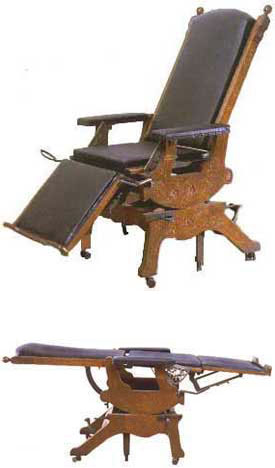 Surgical chairs, as a category of medical furniture, date from about 1870 through 1920. Their appearance coincided with the advent of new diagnostic instruments, the rise of medical specialties, and the development of office practice by physicians. The “Perfection physician’s chair,” seen here, was manufactured around 1890 by the Miner & Elbreg Co. of Indianapolis, Indiana. Like many physician’s chairs of the era, it served as an examining chair, but it also could be converted into a surgical table.
Surgical chairs, as a category of medical furniture, date from about 1870 through 1920. Their appearance coincided with the advent of new diagnostic instruments, the rise of medical specialties, and the development of office practice by physicians. The “Perfection physician’s chair,” seen here, was manufactured around 1890 by the Miner & Elbreg Co. of Indianapolis, Indiana. Like many physician’s chairs of the era, it served as an examining chair, but it also could be converted into a surgical table.
Convertibility did more than save space; it also concealed function. Instrumental examinations, particularly with the vaginal speculum, offended patients’ modesty and made physicians uncomfortable. To allay fears and misgivings, physicians disguised their examining and surgical chairs as parlor furniture. Concern over patients’ emotional response to medical furniture was clearly in the mind of J. Marion Sims, pioneer of gynecological surgery as he described the convertible chair he employed:
For all practical purposes [the chair] is really no better than a common table; but any patient would sit in the chair without nervous agitation, while some become greatly alarmed at being requested to mount a table. The patient once seated, is told that the chair is only a couch, and she is requested to lean back and extend it horizontally by her own weight, with perhaps a little assistance from the nurse who stands at the back of the chair. I am almost afraid to write these little things, but I do it only for my younger brethren, who many need to learn the importance of educating their patients to feel that everything is being done that delicacy and propriety require on an occasion so trying to a sensitive nature.
J. Marion Sims, Clinical notes on uterine surgery. 1st Am. ed. New York, 1873, 22.
By the beginning of the 20th century, the convertible physician’s chair passed out of favor, replaced by the austere examining table. As medicine proved its ability to treat injuries and ailments previously thought incurable, people were apparently less affected by the mere sight of medical equipment. Moreover, the triumph of aseptic protocol in surgery spelled the demise of wood and upholstered furniture, and spawned the advent of sterile, enamel-on-metal and glass furniture.
